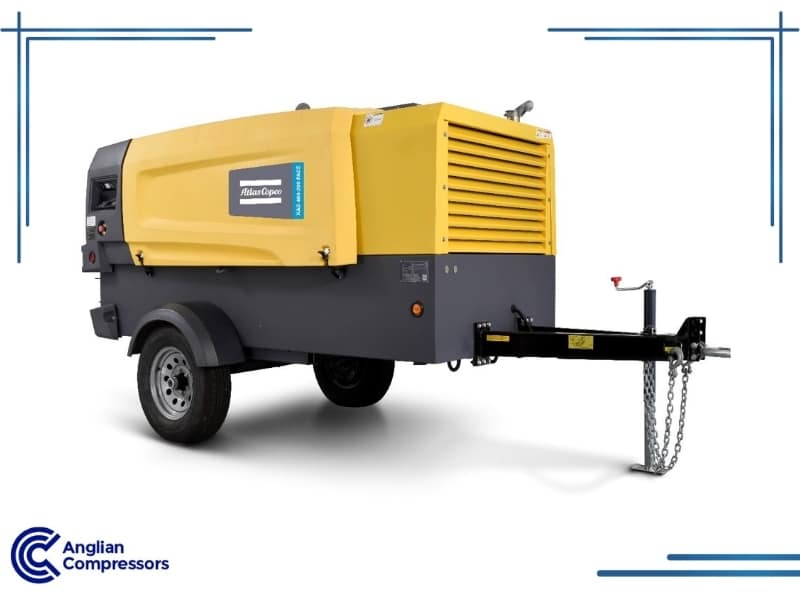Air Compressor CFM
Air tools and other applications require pressurised air. How much air depends on each application. Other factors come into play, including CFM, which stands for cubic feet per minute. This refers to the volume of compressed air that flows over a minute.
An air compressor CFM rating is important. For instance, a higher CFM rate suggests a compressor is more capable of producing enough compressed air to power various air tools.
When considering an air compressor, compressed air, airflow, and other matters, look at it in context. If used together, a couple of air tools require sufficient steady air pressure and flow rate to operate well. If there is too much or too little CFM, your plant or factory will operate inefficiently.
This blog post fully examines CFM and other related metrics to understand our prospective and current customers better.
What Does CFM Mean for Air Compressors?
Compressed air flow rates change when different pressure rates (e.g. PSI) are applied. Therefore, CFM rates vary for the same air compressor when using 100 PSI versus 60 PSI. This naturally creates confusion for people new to a compressed air system.
Standard conditions are applied for CFM to compare apples to apples. This includes a 68°F (c 20°C) temperature and an air compressor located at sea level. Other factors, such as humidity levels, play into calculations too. Standardisation helps give buyers a starting point when comparing CFM while looking for the right air compressor.
The application use case – how the compressed air will be used – is also relevant. Pneumatic air tools and air-operated factory equipment need consistent airflow at a high enough PSI; otherwise, they perform poorly or not at all. Pressure drops must be avoided.
CFM vs SCFM vs ACFM: What is the Difference?
Let us look at the differences and relevance between CFM, SCFM, and ACFM measurements. Here, things get a little more nuanced.
CFM
CFM means cubic feet per minute. This is the volume of air that travels through a compressor, reaching the output end.
Selecting an air compressor with a high CFM rating is essential for applications requiring a high airflow volume during operations..
A rough ratio is to multiply tool CFM requirements by 1.5. Therefore, if powering a single air tool requires a CFM of 7, an air compressor with a CFM of 10.5 is needed.
SCFM
SCFM means standard CFM. This refers to the CFM of an air compressor with a set of standardised conditions.
The standardised conditions are 68°F (c 20°C), 14.7 PSI, and 36% humidity at sea level.
Pressure rates affect SCFM, altering calculations for 90 PSI compared to 120 PSI, for example.
ACFM
ACFM refers to actual CFM. This rating confirms the real CFM compressor output when adjusted for estimated variances, such as temperature, altitude, humidity, etc.
This precision replaces the previous rough calculation suggested for multiplying CFM by 1.5 to determine how much CFM an air compressor requires for a planned application.
Realistic comparisons are made possible between different compressors’ metrics by understanding the differences between CFM, SCFM, and ACFM.

How to Calculate CFM Requirements for Your Tools
The basic formula for calculating CFM requirements for different pneumatic tools is as follows:
CFM = Air Required Multiplied by Duty Cycle Divided by 100
The duty cycle refers to how often the compressor is actively producing air. If it operates half the time, the duty cycle is 0.50.
Tools require different CFMs to operate. Never assume they all require similar air volume or PSI inputs. When calculating compressor CFM needs, consider how many tools will operate concurrently and their various CFMs; a spray gun at a workshop may require up to 14 CFM, whereas an impact wrench only needs 5 CFM.
As a guideline, always add a safety buffer of 30%. This allows for less efficient air systems and some air leakages.
Need assistance calculating CFM requirements? Our air compressor experts at Anglian Compressors, a branch of Atlas Copco, can assist you.
Factors That Affect CFM in Air Compressors
Different factors affect CFM with compressors.
Temperature – air density is reduced at higher temperatures. This affects CFM output levels.
PSI Relationships – higher air resistance with strong PSI results in lower CFM.
Altitude – air density decreases with higher altitudes. A higher CFM machine is necessary to compensate when operating at altitudes above sea level.
Increasing CFM: Tips and Tricks
Below are some quick tips and nifty tricks to increase CFM.
Lower PSI: when it is not needed, reduce PSI. This lowers air resistance and often increases CFM output.
Add Storage Tanks: adding a storage tank provides an air reserve to deliver necessary airflow (CFM) even when the air compressor is out of its duty cycle.
Multi-Compressor System: operating multiple air compressors boosts overall CFM while putting less pressure on a single compressor.
Choosing the Right CFM for Your Applications
When choosing air compressor systems, know your planned application vs air system capability. If running two tools, combine their CFMs.
Below is a quick idea about average CFM air needs for different tool categories.
Light-Duty Tools: 1–5 CFM approximately. These include tyre inflators and nail guns.
Medium-Duty Tools: 5–15 CFM approximately. Such tools include drills and impact wrenches.
Heavy-Duty Tools: 15+ CFM. These tools include paint sprayers in vehicle workshops, as well as sandblasters. Each requires high, sustained CFM output levels.
Matching requirements for both CFM and PSI ensures pneumatic tools run efficiently. Unintended pressure drops affect this. Therefore, a margin of safety in your calculations is advisable.
If you are unsure how your collection of tools stacks up, contact Anglian Compressors, a branch of Atlas Copco. We are always happy to help.
Common Myths About CFM Debunked
Myth 1 – many types of CFM ratings are similar or interchangeable. Significant differences are present between SCFM and ACFM. Do not guesstimate. Seek help from compressor professionals where needed.
Myth 2 – a higher CFM is superior. This depends on the application and PSI suitability. Too much CFM versus requirements leads to overcapacity, higher purchase costs, and increased energy expenditures.
Myth 3 – CFM is the determining factor in performance. The interrelation of compressor engine horsepower (HP) and PSI is relevant here. Avoid looking primarily at CFM.
Conclusion: Why CFM Matters When Buying an Air Compressor?
CFM is a way to pair air compressor output to application requirements – choosing wisely ensures your air system can run all the necessary tools.
To achieve optimal performance, look at both PSI and CFM. Each has relevance. Also, the potential sea level and humidity variances at the installation site should not be overlooked.
Do you need a personalised recommendation for an air system? Get in touch with our professional air consultants at Anglian Compressors, a branch of Atlas Copco. We have the answers.


